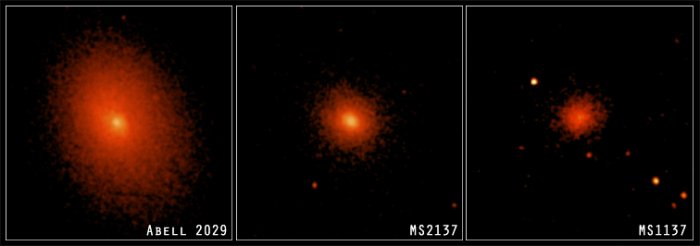
X-ray missions produce a wide range data in many forms. The main three are discussed here; they all result from the type of detector used in X-ray telescopes and also from the fact that X-rays are very high energy. This means that they act as particles rather than waves and so it is easy to measure the energy of each individual photon. They can also record the time a photon hit the detector and also where it came from, to a very high accuracy in the case of CHANDRA.
 |
| Three different clusters as imaged by the CHANDRA satellite. They show the diffuse nature of clusters, and the right-hand one also shows some point sources. The clusters are all at different redshifts and so are at different stages of evolution. (Image courtesy CHANDRA) |
Images are the most easily accessible result from X-ray missions. The raw output of an X-ray detector is the "events" file - which shows how many photons hit each pixel of the detector. However the extra information, for example the energies of the photons, give a greater insight into what is going on in the object under study. A lot of the X-ray research that are presented here are images, though the spectral information (see below) add that extra dimension.
Spectra are when the light is split up into different wavelengths or energies - a rainbow is a spectrum. This can show information like how many X-rays are coming from the object at a particular energy. There are also some electron transitions which have lines in the "soft" (low-energy) X-ray band. If these are not there then we can tell that, for example, there is very little (or even no) cool X-ray gas in Clusters of galaxies (which poses a problem!).
From the combination of images and spectra we can build up detailed models of what the conditions are inside a cluster of galaxies or close to a black hole by matching what we see to the model.
As the detectors can tell when each photon hit, it is trivial to see if a sources' emission is varying in time. In the case of a stellar X-ray source, an X-ray binary for example, or the emission from an Active Galactic Nucleus (AGN), this is useful to show the orbital period of the source (or part of it). However, from some X-ray sources there is no periodic pattern, a feature which is still not entirely understood.
BACK: History of X-ray Astronomy UP: Introduction to X-rays NEXT: X-ray Satellites